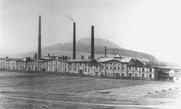A Colorful History
Heubach’s history is a unique story. It is a story that is typical of its time. It is a story of entrepreneurial courage and social change. And it is the story of a companies that have existed for more than 200 years and merged two years ago.


In 1806, the foundation of the Goslaer Farbenfabrik marked the beginning of the pigment business we know today. It was carried on by Julius Westen, a partner of Louis Heubach and Eduard Heuäcker as well as Louis’ father-in-law, who built additional facilities in the towns of Oelze and Osterwieck.
It was a time of great political and economic upheaval. A year earlier, in 1805, Napoleon had marched across the Rhine and over the next ten years took over almost whole of Europe. In the same year, the Frenchman Joseph-Marie Jacquard presented a weaving machine controlled by punched cards. From today’s perspective, this is regarded as a decisive trigger for the Industrial Revolution, the transition from an agrarian society to the industrial economy.

A few decades later, another remarkable color story began a little further southwest, in Höchst on the banks of the Main. In 1863, Carl Friedrich Wilhelm Meister, Eugen Lucius and Ludwig August Müller founded the “Theerfarbenfabrik Meister, Lucius & Co.”, a factory that produced paints from coal tar, a waste material from coke production. Soon after the start, Adolf von Brüning took over Müller’s shares and was the namesake for further development. The three inventors set a boom in motion that spread to many European countries. Several companies producing pigments and dyes were established along the Rhine. These included the aniline factory of Edouard Sandoz and Alfred Kern in 1886, the nucleus of Sandoz and later Clariant, both based in Switzerland.

The products from these three strong roots form the foundation of the product range of today’s Heubach Group. Pigments that are manufactured by many producers today were invented by its ancestors. One of these is Violett 23, invented in 1928 by Hoechst. It is one of the highest-volume products in the pigment sector worldwide – used in many applications. Groundbreaking successes were also achieved by Heubach with the Tico product range, products that replace chromium and lead, as well as Heubach’s anti-corrosive pigments, which mark the industry standard.
The first half of the 20th century was an eventful one for the two companies Sandoz and Hoechst. In addition to colorants, they had developed a wide range of products in the chemical and pharmaceutical sectors. Heubach, on the other hand, had remained loyal to pigments and grew with these core products.
The social awakening of the 60s and 70s needed color in life. The economic upturn was based on new freedoms. It couldn’t be colorful enough. The business of the colorants divisions of Sandoz, Hoechst and Heubach flourished. Numerous subsidiaries abroad and huge exports ensured exponential growth.

Heubach also expanded: in 1984, the pigment division of Dupont des Nemours was purchased, and only a few years later another factory was built in Fairless Hills, PA.
In 1994, construction finally began on the factories in India that are now among the largest production sites for blue and green organic pigments. Further acquisitions of the pigment business of large international groups by Heubach contributed to further growth of the company.
The Swiss company Clariant surprised the market in 1997 when it bought the pigments division along with the much larger specialty chemicals division of the German Hoechst AG. This subsidiary then operated as Colorants International together with the merged Sandoz color business and was represented worldwide. The story reached a new stage in January 2022 when Heubach Group and SK Capital, a private investment firm with focus on specialty materials, chemicals and pharmaceuticals sectors, completed the acquisition of the global pigment division of Clariant AG.